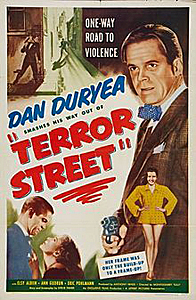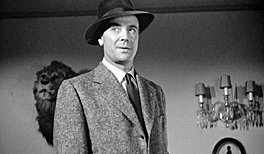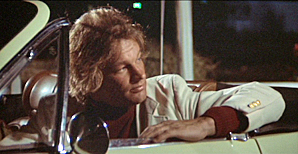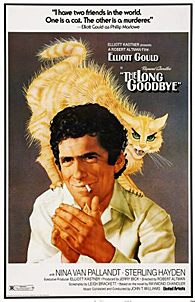TERROR STREET. Lippert Films, US; Hammer Films, UK, as 36 Hours, 1953. Dan Duryea, Elsy Albiin, Ann Gudrun (Gudrun Ure), Eric Pohlmann, John Chandos, Kenneth Griffith. Story and screenplay: Steve Fisher. Director: Montgomery Tully.
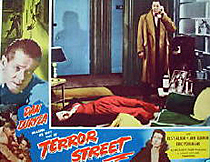
This is one of several movies recently marketed on DVD in this country as “Hammer Noir” films. What they were in reality were joint British-American productions in which a single star was imported from the US (Dan Duryea, of course, in this case) to make a movie — quite often a crime film — on a low budget in England, with the rest of the cast consisting only of British and European actors and actresses.
On the basis of Terror Street, I’d say that the emphasis is on the cheap, with inexpensive sets prevailing; on the other hand, there is plenty of exterior shooting that provides a glimpse of the non-touristy areas of London in the early 1950s.
But before going any further, let me tell you about the story. Dan Duryea plays an American flier named Rogers who marries a Norwegian girl (Elsy Albiin) he meets in England after the war, and they settle down there. When he’s called back to the States for some sort of training program, they have their first quarrel. Three months having turned into a year without hearing from her, he goes AWOL and heads back to England to see her and to learn why she’s cut off all contact with him.
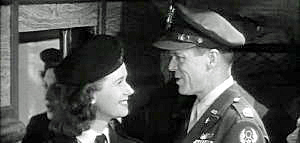
And guess what. She opens the door to her apartment where he’s sitting quietly waiting for her, he’s clunked on the head from behind, and he wakes up to find her shot to death beside him, his gun (and the murder weapon) in his hand.
Not waiting for the police to arrive for them to not believe his story, he heads out on the lam — and straight into the arms of Jenny Miller (Ann Gudrun) who works in a charity kitchen, which may help to explain why she takes him on as a charity case of her own.
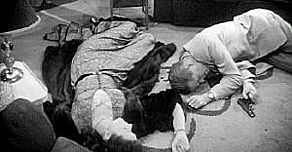
This is not a detective story — we the viewers have already seen the killer do the deed, although of course we do not know who he is or why he did it. Nor, believe it or not, is this much of a suspense yarn, even though that’s the gimmick that’s meant to keep the story moving: Rogers has only 36 hours before his superiors learn that he’s gone, having smuggled himself into England without either their knowledge or permission.
In those 36 hours, his quest is not only to find the killer and clear himself, but to discover why the long-distance romance with his wife broke up so badly. Not realizing in the meantime that Jenny is becoming more and more important to him, and vice versa, only I think she realizes it first. Various sleazy types try to stop them.
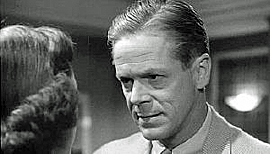
A true noirish situation, right? It was concocted by a writer who started his career writing for the pulp magazines, but this time, nothing that happens seems to ring true, and Duryea appears almost too tired and out of sync to pull off the role he’s to play here, that of both hero and victim. (In his early days of film-making, as you probably need not be reminded, Duryea was usually a villain.)
Other than Duryea, the actors are rather stolid folk, with only Ann Gudrun, who was born in Scotland, showing much spark. She was only 5 foot 3, I’m told, but she plays her role with a restrained combination of wistfulness and strength.
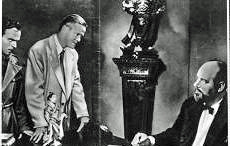
Elsy Albriin is pretty without being beautiful, and if she’d been given a longer role, maybe some of the stiffness she shows early on would have worn away. She did not have a very long career in either TV or the movies, especially in English-speaking roles.
One last generalization, then, and I think it applies here as well. Whenever I watch a movie and all I see are actors standing on a soundstage, that’s when I know when neither the story nor the players has any kind of hold on me. No mesmerizing movie-time spells were cast this time. While in no sense did I find Terror Street disastrously bad, watching it was largely a disappointment for me.





